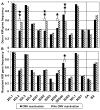The effect of single and combined activating killer immunoglobulin-like receptor genotypes on cytomegalovirus infection and immunity after hematopoietic cell transplantation
- PMID: 19203722
- PMCID: PMC2770248
- DOI: 10.1016/j.bbmt.2008.11.030
The effect of single and combined activating killer immunoglobulin-like receptor genotypes on cytomegalovirus infection and immunity after hematopoietic cell transplantation
Abstract
It has been shown that activating killer Ig-like receptor (aKIR) genes are important for control of cytomegalovirus (CMV) reactivation after hematopoietic cell transplantation (HCT). To date, using the broad classification of KIR haplotypes A and B, the precise role of individual KIR genes in the control of infection cannot be discerned. To address this, a consecutive case series of 211 non-T cell-depleted HCT patients all at risk for CMV were monitored biweekly for CMV DNA in plasma by quantitative polymerase chain reaction (Q-PCR) and at intervals for CMV-specific T cell immunity. Comparing patients with CMV reactivation (n = 152) to those with no reactivation (n = 59), the presence of specific aKIR haplotypes in the donor, but not in the recipient, were associated with protection from CMV reactivation and control of peak plasma CMV DNA (P < .001). A donor aKIR profile, predictive for low risk of CMV reactivation, contained either aKIR2DS2 and aKIR2DS4 or had >/=5 aKIR genes. Neither donor nor recipient inhibitory KIR (iKIR) played a role in a protective effect. CD4(+)- and CD8(+)-specific CMV immunity did not explain reduced CMV infection. The initial control of CMV infection after HCT is managed by aKIR functions, and donor aKIR haplotypes deserve further evaluation in donor selection for optimized HCT outcome.
Figures

 n=59, having no CMV reactivation). The KIR gene frequency is separately portrayed for donors (Panel A) and recipients (Panel B). aKIR2DS4d represents the deletion variant of aKIR2DS4. iKIR2DL4, iKIR3DL2 and iKIR3DL3 were detected in all members of this cohort, and thus omitted from this figure. AA indicates individuals homozygous for KIR haplotype A, and BX indicates individuals either heterozygous (BA) or homozygous (BB) for KIR haplotype B. * p= 0.06, ** p≤ 0.05 using the Chi-square test.
n=59, having no CMV reactivation). The KIR gene frequency is separately portrayed for donors (Panel A) and recipients (Panel B). aKIR2DS4d represents the deletion variant of aKIR2DS4. iKIR2DL4, iKIR3DL2 and iKIR3DL3 were detected in all members of this cohort, and thus omitted from this figure. AA indicates individuals homozygous for KIR haplotype A, and BX indicates individuals either heterozygous (BA) or homozygous (BB) for KIR haplotype B. * p= 0.06, ** p≤ 0.05 using the Chi-square test.


Similar articles
-
Expression of activating KIR2DS2 and KIR2DS4 genes after hematopoietic cell transplantation: relevance to cytomegalovirus infection.Biol Blood Marrow Transplant. 2011 Nov;17(11):1662-72. doi: 10.1016/j.bbmt.2011.04.008. Epub 2011 Apr 29. Biol Blood Marrow Transplant. 2011. PMID: 21596150 Free PMC article.
-
Cytomegalovirus reactivation after matched sibling donor reduced-intensity conditioning allogeneic hematopoietic stem cell transplant correlates with donor killer immunoglobulin-like receptor genotype.Exp Clin Transplant. 2011 Feb;9(1):7-13. Exp Clin Transplant. 2011. PMID: 21605017
-
Donor-recipient killer immunoglobulin like receptor (KIR) genotype matching has a protective effect on chronic graft versus host disease and relapse incidence following HLA-identical sibling hematopoietic stem cell transplantation.Ann Hematol. 2018 Jun;97(6):1027-1039. doi: 10.1007/s00277-018-3274-0. Epub 2018 Mar 16. Ann Hematol. 2018. PMID: 29549412
-
Potential Beneficial Effects of Cytomegalovirus Infection after Transplantation.Front Immunol. 2018 Mar 1;9:389. doi: 10.3389/fimmu.2018.00389. eCollection 2018. Front Immunol. 2018. PMID: 29545802 Free PMC article. Review.
-
Strategies to activate NK cells to prevent relapse and induce remission following hematopoietic stem cell transplantation.Blood. 2018 Mar 8;131(10):1053-1062. doi: 10.1182/blood-2017-08-752170. Epub 2018 Jan 22. Blood. 2018. PMID: 29358179 Free PMC article. Review.
Cited by
-
Influence of KIR and NK Cell Reconstitution in the Outcomes of Hematopoietic Stem Cell Transplantation.Front Immunol. 2020 Sep 2;11:2022. doi: 10.3389/fimmu.2020.02022. eCollection 2020. Front Immunol. 2020. PMID: 32983145 Free PMC article. Review.
-
Activating KIRs and NKG2C in Viral Infections: Toward NK Cell Memory?Front Immunol. 2015 Nov 9;6:573. doi: 10.3389/fimmu.2015.00573. eCollection 2015. Front Immunol. 2015. PMID: 26617607 Free PMC article. Review.
-
Diverse functionality among human NK cell receptors for the C1 epitope of HLA-C: KIR2DS2, KIR2DL2, and KIR2DL3.Front Immunol. 2012 Nov 22;3:336. doi: 10.3389/fimmu.2012.00336. eCollection 2012. Front Immunol. 2012. PMID: 23189078 Free PMC article.
-
Donor activating KIR3DS1 is associated with decreased acute GVHD in unrelated allogeneic hematopoietic stem cell transplantation.Blood. 2010 Apr 15;115(15):3162-5. doi: 10.1182/blood-2009-08-236943. Epub 2010 Feb 1. Blood. 2010. PMID: 20124216 Free PMC article.
-
Role of Immunogenetics in the Outcome of HCMV Infection: Implications for Ageing.Int J Mol Sci. 2019 Feb 5;20(3):685. doi: 10.3390/ijms20030685. Int J Mol Sci. 2019. PMID: 30764515 Free PMC article. Review.
References
-
- Lanier LL. NK cell recognition. Annu Rev Immunol. 2005;23:225–274. - PubMed
-
- Gerosa F, Gobbi A, Zorzi P, et al. The reciprocal interaction of NK cells with plasmacytoid or myeloid dendritic cells profoundly affects innate resistance functions. J Immunol. 2005;174:727–734. - PubMed
-
- Moretta A, Marcenaro E, Parolini S, Ferlazzo G, Moretta L. NK cells at the interface between innate and adaptive immunity. Cell Death Differ. 2008;15:226–233. - PubMed
-
- Vilches C, Parham P. KIR: diverse, rapidly evolving receptors of innate and adaptive immunity. Annu Rev Immunol. 2002;20:217–251. - PubMed
-
- Carrington M, Martin MP. The impact of variation at the KIR gene cluster on human disease. Curr Top Microbiol Immunol. 2006;298:225–257. - PubMed
Publication types
MeSH terms
Substances
Grants and funding
LinkOut - more resources
Full Text Sources
Medical
Research Materials

